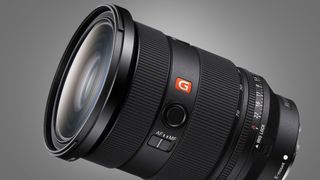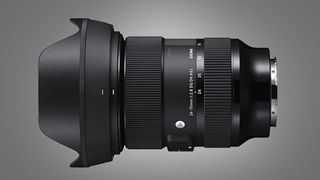Sony’s new zoom lens shows it still has the edge on Canon and Nikon
Sony is still on a mirrorless camera lens hot streak

Sony's mirrorless cameras had a big head-start on their Canon and Nikon rivals – and its new zoom lens is a reminder that it still holds the edge on those two giants when it comes to glass.
Canon and Nikon have done well to bolster the lens ranges for their RF and Z-mount cameras, which only arrived in 2018. They respectively now have 26 and 27 lenses available for their mirrorless cameras, even if many of those lenses are out of stock. Both companies also let you adapt lenses made for their older DSLRs.
But Sony's new FE 24-70mm f/2.8 G Master II, and the E-Mount lineup it's part of, shows that Canon and Nikon are still playing catch-up. This new mid-range zoom is another classy addition to its 'G Master' lineup, which are its top-range pro lenses. And tellingly, it's a second-generation follow-up to the original lens Sony launched back in 2016.
Canon and Nikon have unmatched heritage when it comes to DSLR lenses, but neither is yet at the stage of making refined sequels to their full-frame mirrorless lenses. The FE 24-70mm f/2.8 G Master II is the smallest and lightest f/2.8 G Master lens in its range. And with this launch, that range of E-mount lenses now stands at an impressive 67 lenses.
Of course, it isn't just a numbers game, and some of those lenses do need updating. But we've been bowled over by the quality of Sony's recent G Master lenses, from the Sony FE 70-200mm f/2.8 GM OSS II to the Sony FE 50mm f/1.2 GM, which we said, "sets a new benchmark for speed and optical quality". And this new mid-range zoom, while also undoubtedly expensive at $2,300 / £2,099 (around AU$3,700), promises to follow in their footsteps.
If you missed the announcement, the FE 24-70mm f/2.8 G Master II weighs only 695g – that's 22% less than its predecessor and considerably lighter than its Canon, Nikon, and Sigma equivalents. The design also promises to serve up some delicious bokeh and be ideal for video shooters, thanks to the inclusion of four XD Linear motors for fast, quiet autofocus and a handy zoom 'smoothness' switch to tweak the zoom ring's torque.
Other bonuses include a ‘floating focus’ mechanism to help control common issues like chromatic aberration and a fluorine coating to keep moisture at bay. We'll wait to test the FE 24-70mm f/2.8 G Master II before reaching any firm conclusions, but on paper, it's shaping up to be the best lens of its kind for photos and video.
Get daily insight, inspiration and deals in your inbox
Get the hottest deals available in your inbox plus news, reviews, opinion, analysis and more from the TechRadar team.
The E-mount family it slots into also remains a step ahead of Canon and Nikon, despite some bold proclamations from those two heavyweights about their mirrorless lens plans.
Analysis: Canon and Nikon in Sony's slipstream

Sony's lens lead over Canon and Nikon isn't too surprising when you consider it launched its first full-frame mirrorless camera back in 2013 – a full five years before its rivals. But Canon and Nikon haven't helped themselves by being resistant to opening up their RF and Z mounts to third-party manufacturers.
In its bid to disrupt the camera world, Sony let the likes of Sigma, Tamron and Zeiss make autofocus-equipped lenses for its E-mount. This means Sony camera owners now have a huge range of mirrorless lenses to choose from – and it's a cake that Sony is happily decorating with impressive creations of its own like the new FE 24-70mm f/2.8 G Master II.
This is why Canon and Nikon have recently made some bold proclamations about their mirrorless camera lens roadmaps. Canon recently stated that it plans to maintain its pace of releasing eight new RF lenses per year for the next four years, while a few weeks ago Nikon promised in a plan that it'll be making 22 more Z-mount lenses by 2025.
Those are bold statements that, despite some inevitable pandemic-related slowdown, should see both camera giants start to catch up with Sony in terms of sheer numbers. Particularly if they start to open up their mounts to third-party manufacturers, like Fujifilm has recently.
But for now, lenses like the FE 24-70mm f/2.8 G Master II show that Sony doesn't intend to let its lead slip – and the quality of those lenses should be a good match for whatever cameras it had planned for 2022, like the rumored Sony A7R V.

Mark is TechRadar's Senior news editor. Having worked in tech journalism for a ludicrous 17 years, Mark is now attempting to break the world record for the number of camera bags hoarded by one person. He was previously Cameras Editor at both TechRadar and Trusted Reviews, Acting editor on Stuff.tv, as well as Features editor and Reviews editor on Stuff magazine. As a freelancer, he's contributed to titles including The Sunday Times, FourFourTwo and Arena. And in a former life, he also won The Daily Telegraph's Young Sportswriter of the Year. But that was before he discovered the strange joys of getting up at 4am for a photo shoot in London's Square Mile.
